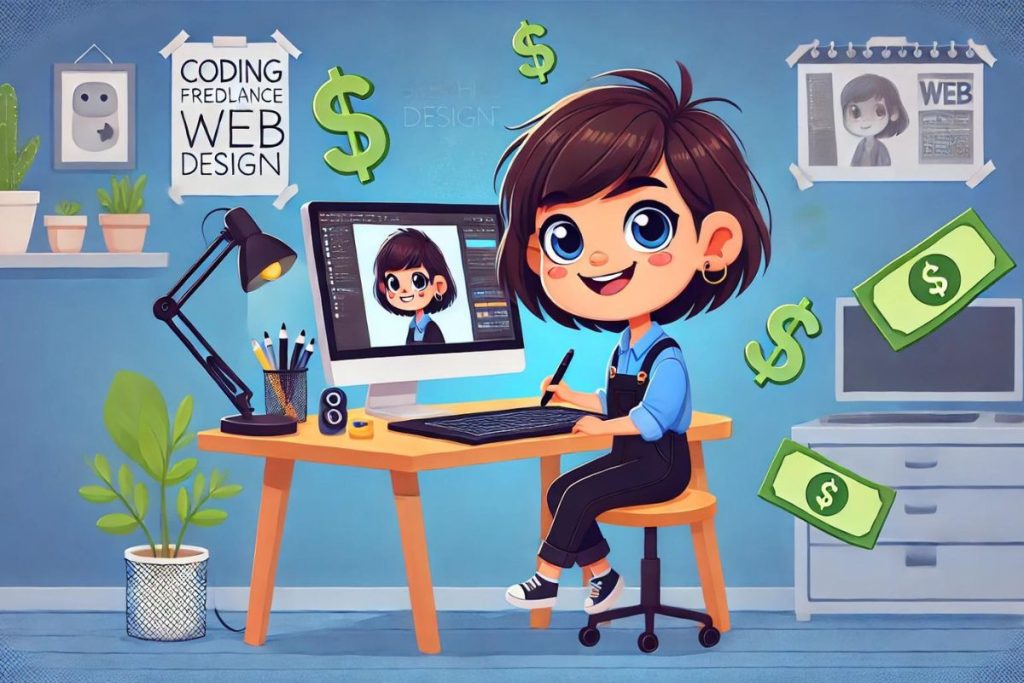Are you captivated by the digital world and eager to turn your creative passion into a thriving career? Becoming a web designer may well be the perfect path for you. In today’s digital age, businesses and individuals alike are constantly seeking talented professionals to craft visually stunning and user-friendly websites.
The journey to becoming a web designer is both exciting and challenging. You’ll need to master a unique blend of technical skills and artistic flair. But don’t worry – with dedication and the right resources, you can transform your dream into reality.
In this guide, we’ll walk you through the essential steps to kickstart your web design career, from acquiring the necessary skills to building an impressive portfolio that’ll catch the eye of potential clients and employers.
What Is Web Design?
Web design is the process of creating and arranging visual elements for websites. It combines planning, conceptualizing, and implementing designs to craft functional and visually appealing online experiences. Web designers focus on developing layouts, graphics, and user interfaces that effectively communicate a website’s purpose and facilitate easy navigation.
Your role as a web designer involves crafting the overall look and feel of websites. You’ll work on visual aspects like color schemes, typography, and imagery. Additionally, you’ll consider user experience factors to create intuitive and engaging interfaces that keep visitors coming back.

Skills Required for Web Design
Web design demands a diverse skill set. To excel in this field, you’ll need to master technical, creative, and soft skills.
Technical Skills
Master HTML, CSS, and JavaScript for coding and structuring websites. Learn graphic design software like Adobe Creative Suite. Develop proficiency in wireframing tools such as Figma or Sketch. Understand responsive design principles for cross-device compatibility. Stay updated on web development trends and best practices.
Creative Skills
Cultivate a keen eye for aesthetics and visual composition. Develop strong typography skills to enhance readability. Hone your color theory knowledge for appealing palettes. Practice creating user-friendly interfaces and intuitive navigation. Explore innovative design trends to keep your work fresh and engaging.
Soft Skills
Communicate effectively with clients and team members. Manage time efficiently to meet project deadlines. Develop problem-solving abilities for technical and design challenges. Cultivate adaptability to handle changing project requirements. Practice active listening to understand client needs and preferences.
Education and Training Options
Web designers have various paths to acquire the necessary skills and knowledge. These options cater to different learning styles, time commitments, and career goals.
Formal Education
Associate degrees offer a foundation in web design, covering general education and technical skills. Bachelor’s degrees provide advanced training in business management and client relations. Post-secondary programs focus on interactive media studies, emphasizing hands-on learning with current technology.
Self-Learning and Online Courses
Web design bootcamps deliver intensive training in 12 weeks, preparing you for job opportunities. Online platforms like Coursera and DesignContest offer courses on web design theory, HTML, CSS, JavaScript, and UX design. These self-paced options allow you to learn at your own speed and convenience.
Building Your Web Design Portfolio
Building a strong portfolio is crucial for showcasing your web design skills and attracting potential clients or employers. Your portfolio demonstrates your abilities, creativity, and professional experience.

Creating Personal Projects
Design your own website to display your skills and personal brand. Create mock websites for fictional businesses or redesign existing sites. Develop mobile apps or landing pages to showcase your versatility. These projects highlight your creativity and technical prowess.
Freelancing and Internships
Take on freelance projects to gain real-world experience and expand your portfolio. Look for internships at design agencies or tech companies to learn industry practices. Volunteer your skills for non-profit organizations or local businesses to build a diverse portfolio and network.
Essential Tools for Web Designers
Web designers rely on various tools to create visually appealing and functional websites. Here are the essential software and tools you’ll need to master:
Design Software
Adobe Creative Cloud is crucial for web designers. It includes Photoshop, Illustrator, and InDesign for creating visual elements and mock-ups. Alternatives like Inkscape and CorelDraw offer similar functionality. For UI design, consider InVision Studio or Sketch. These tools help you craft engaging website designs efficiently.
Coding Tools
HTML, CSS, and JavaScript are fundamental coding languages for web designers. Text editors like Sublime Text or Visual Studio Code streamline coding processes. Browser developer tools assist in debugging and testing. Version control systems like Git help manage code changes. Familiarity with these tools enhances your web design capabilities.
Staying Current in Web Design
Staying current in web design is crucial for success in this fast-paced field. Keeping up with industry trends and pursuing continuous education helps you maintain a competitive edge.
Following Industry Trends
Stay informed about the latest web design developments. Follow industry experts and mentors on social media platforms like Twitter and LinkedIn. Join professional organizations such as AIGA to network and learn from peers. Attend web design conferences and workshops to gain insights into emerging technologies and best practices.
Continuing Education
Pursue formal education options like bachelor’s or master’s degrees in graphic design or IT. Take online courses and certifications to fill skill gaps and learn new software. Explore platforms like Coursera, Udemy, or Skillshare for web design-specific courses. Regularly practice coding and design skills to stay sharp and adaptable in the industry.
How Much Does a Web Designer Make?
Finding Web Design
Web designers’ salaries vary significantly based on location, experience, and industry.
In the United States, the average annual salary for a web designer is approximately $70,000, with hourly rates around $33.65. Entry-level positions start at $52,349 per year, while experienced designers can earn up to $100,216 annually, according to Talent.com and Built In.
In the United Kingdom, web designers earn an average of £30,000 per year, with hourly rates around £15.38. Entry-level positions start at £25,000, while experienced designers can earn up to £40,000 annually, as reported by Talent.com.
In Canada, web designers earn an average annual salary of CAD 60,450, with hourly rates around CAD 31. Entry-level positions start at CAD 50,000, while experienced professionals can earn up to CAD 75,000 per year, according to Talent.com.
In Australia, the average annual salary for a web designer is AUD 91,699, with hourly rates around AUD 47.02. Entry-level positions start at AUD 73,800, while experienced designers can earn up to AUD 120,000 annually, as reported by Talent.com and Glassdoor. These figures highlight the variability in web designer salaries across different regions and levels of experience.
Jobs
Landing web design jobs requires a strategic approach and persistence. Here are effective ways to find opportunities:
Networking and Job Boards
Attend industry events and join professional groups to expand your network. Utilize job boards like Indeed, Glassdoor, and Dribbble Jobs to find web design positions. Engage with other designers on social media platforms like LinkedIn and Twitter to stay informed about job openings.
Freelance Platforms
Create profiles on freelance platforms such as Upwork, Fiverr, and 99designs. These sites connect you with clients seeking web design services. Build your reputation by completing projects and earning positive reviews. Showcase your best work to attract high-quality clients and increase your chances of landing long-term contracts.
Career Growth in Web Design
Entry-Level Opportunities
Web design offers numerous entry-level positions. Junior web designers often start in agencies or in-house design teams. These roles provide valuable experience and mentorship. You’ll work on diverse projects, honing your skills and building a professional network.
Mid-Level Advancement
As you gain experience, opportunities for advancement increase. Senior web designer positions involve more complex projects and client interactions. You may lead small teams or specialize in areas like UX design or front-end development. Mid-level designers often take on mentoring roles for junior staff.
Leadership Roles
Experienced web designers can progress to leadership positions. Art directors and creative directors oversee entire design departments. These roles require strong management and strategic skills. You’ll shape the creative direction of projects and guide teams to achieve client goals.
Freelancing and Entrepreneurship
Many web designers choose to freelance or start their own agencies. This path offers flexibility and the potential for higher earnings. You’ll need to develop business skills alongside your design expertise. Building a strong client base and reputation is key to success in this arena.
See more:

